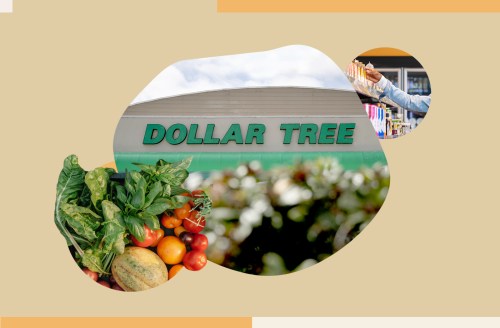Dollar Stores Aren’t the Answer To Alleviating Food Insecurity, So What Is?
Experts discuss dollar stores and food insecurity, weighing the pros and cons of how dollar stores help and hurt those in low-income areas.

There are more than 31,000 Dollar General, Dollar Tree, and Family Dollar stores in 46 states across the U.S.—and that’s not counting all the discount variety stores without brand names. These stores have six times as many locations as Walmart, and 11 times the number of grocery stores owned by Kroger (which is the largest grocery-store operator in the country). All of this is to say that dollar stores are everywhere—including in areas where there isn’t much else.
Experts in This Article
Allison Karpyn, PhD is an an associate professor and senior associate director of the University of Delaware’s Center for Research in Education and Social Policy.
Kayleigh Painter is the manager of investor and media relations at Dollar Tree.
Lauren Ornelas is the founder and president of the Food Empowerment Project, a non-profit committed to create a more just and sustainable world by recognizing the power of one’s food choices.
Mary Jane Lyonnais is the healthy foods coordinator with Partnerships to Improve Community Health, located in Eastern North Carolina.
For many of the 13.5 million people in the U.S. with limited access to supermarkets or large grocery stores, dollar stores are one of the few places besides gas stations and convenience stores where they can buy food. Many dollar stores also accept Electronic Benefit Transfer (EBT), which is how states issue SNAP (Supplemental Nutrition Assistance Program) food benefits.
It’s exactly because dollar stores are the primary food supplier for so many people in the U.S. that they’ve become the center of a complicated debate about the best ways to solve food insecurity, the state of having limited or inconsistent access to food. Critics have accused dollar stores of taking advantage of their customers by limiting access to healthy foods. But if dollar stores—with their power to be seemingly everywhere—aren’t the answer to alleviating food insecurity, what is?
The complicated legacy of dollar stores
Dollar stores typically operate in low-income areas without grocery stores, according to a paper published in the International Journal of Environmental Research and Public Health. “Our research found that about 60 percent of dollar-store [shoppers come from] households with incomes less than $50,000 a year, and 30 percent [earn] less than $25,000 a year,” says Allison Karpyn, PhD, an associate professor and senior associate director of the University of Delaware’s Center for Research in Education and Social Policy and the co-author of a paper published in UNSCN Nutrition that discusses how people in food-insecure areas shop for groceries.
Dollar stores often act as substitute grocery stores for people living in low-income areas, which has its pros and cons. As mentioned, these stores accept EBT. These stores might also be more welcoming to low-income customers. “Customers who don’t have a lot of money and have a fear of overspending don’t feel the shame of having to put something back in dollar stores,” Dr. Karpyn says. Dollar stores often represent full- and part-time job opportunities for people in low-income communities, adds Dollar Tree media relations representative Kayleigh Painter. “Within the past year, more than 35,000 of our valued associates were promoted into new positions within the organization.”
However, the actual food sold at dollar stores has long been criticized by some experts. Vegan food activist and Food Empowerment Project founder Lauren Ornelas points out that dollar stores typically don’t stock organic options, for example. There are also typically more nutrient-poor foods than nutritious options on the shelves, and very few locations sell fresh produce. (The exception: Dollar General sells produce at 650 of its 26,000 locations.) However, when dollar stores do sell produce, research shows the quality is just as good as what you’d find in conventional grocery stores.
When asked why Dollar Tree stores don’t carry more healthy options (and no produce items), Painter says it’s actually not their intention to serve as a full-blown grocery store. “Our stores provide an affordable and convenient fill-in shopping option for our customers in between their weekly or bi-weekly grocery store trips,” she says. But this thinking assumes dollar store shoppers have access to bigger grocery stores, which is not actually the case. A report on dollar stores published by the Institute For Local Self-Reliance found that dollar stores concentrate in areas with little or no grocery stores—making them one of the few food options available for people who live there.
Painter says dollar stores choose what to stock based on customer preferences, but Ornealas says “customer preferences” is more nuanced than what many chose to believe—on both sides of the coin. “The needs are different in each community,” she says. “We’ve certainly worked in communities where people very much want access to healthier foods. Many people in these areas come from other countries where they’re used to having fresh fruits, vegetables, and herbs.” But Ornelas says people in these communities often work long hours and don’t have much time to cook, which is why they may seek out ready-made foods. “Cooking is a privilege and some people don’t have much of a choice,” she says.
Dollar stores may be providing short-term assistance to people who are food insecure, but given their limited healthy food options, they’re a short-sighted solution to food insecurity. This raises the question: Why aren’t there more grocery stores in places where they’re needed, and what is the answer to helping those in need for the long-term?

Better solutions to solving food insecurity—and where dollar stores fit in
The seemingly obvious solution would be to start opening more grocery stores in lower-income areas. Unfortunately, that prospect can be unappealing to grocery store developers, according to Mary Jane Lyonnais, a regional healthy foods coordinator for Partnerships to Improve Community Health in Eastern North Carolina and a co-author of a paper about food shopping habits of people in the region. Big grocery stores take a lot of capital to open, and the profit margins are low. “This makes it very difficult to acquire investors, loans, and other funding to support grocery-store operations in areas that do not generally have a lot of resources to begin with,” says Lyonnais.
This is why Lyonnais believes local governments should offer tax incentives to grocers to entice them to open stores in these areas. Another policy change that could help: “Incentivizing the purchase of produce by offering benefits to SNAP participants that make fruits and vegetables more affordable,” says Lyonnais.
Retailers have also engaged in shady business practices that have made it harder to get grocery stores to stay in lower-income areas. “Something disturbing [Food Empowerment Project] found is that sometimes a grocery store will leave a location and relocate to an area that’s more suburban. There will be a clause in their lease saying another grocery store cannot take over the space for a certain amount of time, like five years,” Ornelas says. The reason, she explains, is that the retailer wants people to travel farther to the new grocery store. That way, the retailer is still getting the business of customers from the old location while also acquiring the business of those who live in the suburban area. But these tactics also make it that much harder for people who have less access to transportation to get to those new stores.
That’s why Ornelas thinks it’s important to look for additional solutions for food insecurity outside of the grocery store. She’s a huge advocate of encouraging community members to grow their own food in community gardens, a solution that can benefit those who don’t have yard space to do this at their homes or apartment complexes. She also likes worker-owned food cooperatives (meaning that people who work there co-own the business and share in its profits). “This will allow community members to have a say in what’s being sold and hours being worked and to make decisions about what will really benefit the community, like offering discounts to seniors or accepting EBT,” she says.
Ornelas also encourages community organizers to think logistically about their local farmers’ markets so they are truly beneficial to community members. “There are more farmers’ markets in more communities, but it’s important that the dates and places are actually convenient to people in the community, and not happening when they are at work,” Ornelas says. “It’s also important that there is signage in the languages spoken in these communities,” she adds.
Above all, healthy food itself needs to be more affordable, regardless of where it is sold, Lyonnais says. After all, adding more grocery stores or farmer’s markets to an area will only go so far if the products sold in those locations are too expensive for people to buy regularly.
These are all solutions that will help alleviate food insecurity, and Dr. Karpyn adds that dollar stores can play a part, too. “Those of us who care about access to affordable healthy food need to look more carefully at how dollar stores have managed to have so much success.” For example, as Dr. Karpyn pointed out, dollar stores excel at making food insecure shoppers feel welcome, and have done so in a way that’s clearly been profitable, despite the criticisms. If grocery stores that sell a wide range of nutritious foods can follow in dollar stores’ footsteps in these ways, it will go a long way.
But Lyonnais says change also needs to be made at a national level, not just within communities. “Policy change will need to be examined in order to alleviate the health issues that are related to diet and accessibility of affordable healthy foods in food deserts,” she says. Beyond tax incentives and expanded SNAP benefits, she says financial or technical assistance to farmers serving low-income populations could help increase access to healthier foods, too.
The role of dollar stores in food-insecure areas is complex. Given just how prevalent they are, they should and must be part of the solution. But policymakers, grocery-store operators, and community planners need to do their parts, too. Only then will the problem of food deserts dry up for good.
Oh hi! You look like someone who loves free workouts, discounts for cult-fave wellness brands, and exclusive Well+Good content. Sign up for Well+, our online community of wellness insiders, and unlock your rewards instantly.










